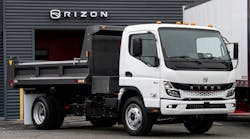At a two-day open house at the Sapp Bros location on I-80 in Omaha, NB, representatives from Shorepower Technologies (which installed 24 plug-in power pedestals at the site); Cascade Sierra Solutions, the non-profit organization administering the US Department of Energy grant; and other industry vendors gathered to give truckers and the public at look at how truckstop electrification can contribute to a healthier environment.
“This central location in Omaha is a key stop for trucking companies to take advantage of electrification that we are introducing to a growing number of truckstops nationally,” said Alan Bates, Shorepower vice president of marketing. “By using shore power at truckstops to reduce idling, among other steps, trucking fleets can save 60 percent or more on energy costs.”
At Sapp Bros and a growing number of truckstops around the country, truckers can plug in to power connections similar to those available at RV parks and marinas. By using 120-volt or 208-volt electricity, truckers can heat or cool their cabs and run appliances-- such as TVs, microwaves and refrigerators-- at a fraction of the cost of idling their vehicles during mandatory rest stops. Sapp Bros is one of two truckstops in Nebraska to offer plug-in power to customers.
“This is a way for trucking to be a good corporate citizen and to contribute to cleaner air,” said Larry Johnson, president of the Nebraska Trucking Association. “And this is an affordable and reliable method for drivers to be comfortable on the road.”
When idling, truckers can burn up to a gallon of diesel fuel an hour, according to Cascade Sierra Solutions. At recent prices of $4 per gallon, idling overnight can cost around $40 and is harder on the engine than when the truck is running on the road. By comparison, plugging in at a Shorepower station costs $1 an hour, according to the company.
“This central location in Omaha is a key stop for trucking companies to take advantage of [the] electrification that we are introducing to a growing number of truckstops nationally,” said Alan Bates, Shorepower vice president of marketing. “By using shore power at truckstops to reduce idling, among other steps, trucking fleets can save 60 percent or more on energy costs.”
By reducing idling, truckers are also helping improve air quality by decreasing emissions of carbon dioxide, nitrogen oxide and particulate matter. By eliminating 1,600 hours of idling annually, a trucker prevents 9.7 tons of carbon dioxide from entering the atmosphere, according to the U.S. Environmental Protection Agency.
“This advanced electric charging technology marks an investment in our future,” said Ginger Wilson, director of the Nebraska Energy Office. “It holds the promise of transforming the trucking industry while reducing emissions and lowering the use of diesel fuels.”
The Omaha truckstop is Sapp Bros’ first location to offer electrification. “We view plug-in power as a benefit to our customers and a way for them to save money and be more efficient,” said Dan Adams, vice president of operations. “Trucking companies need to cut expenses, and we want to help them do that. When our customers win; we win.”
The Sapp Bros site is one of 50 truckstops planned nationwide to get power pedestals in 2012 through the Shorepower Truckstop Electrification Project, a U.S. Department of Energy program partnering Shorepower Technologies with Cascade Sierra Solutions (CSS). CSS administers the program, which also includes rebates for trucking operators to purchase idle-reduction equipment.


